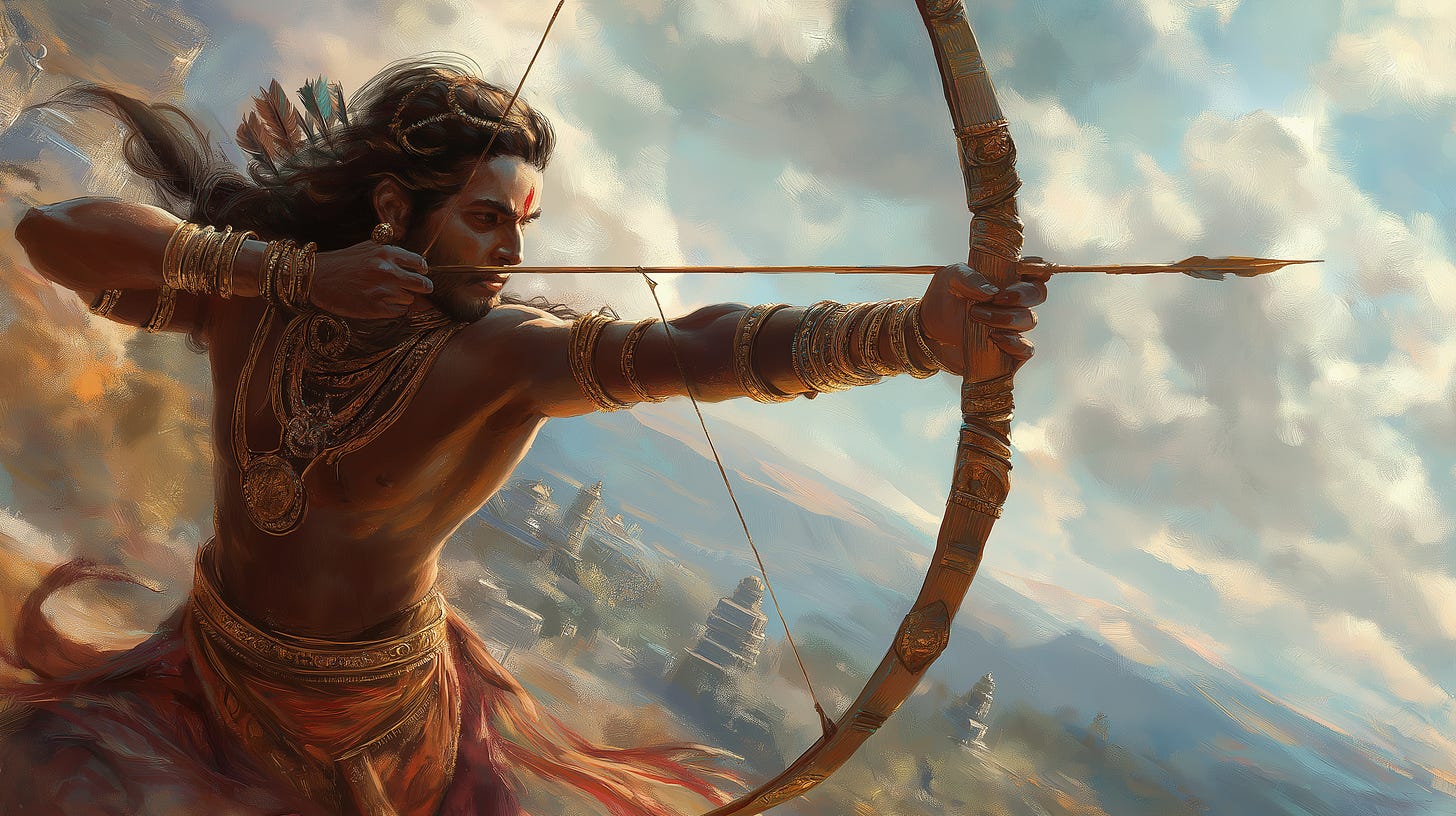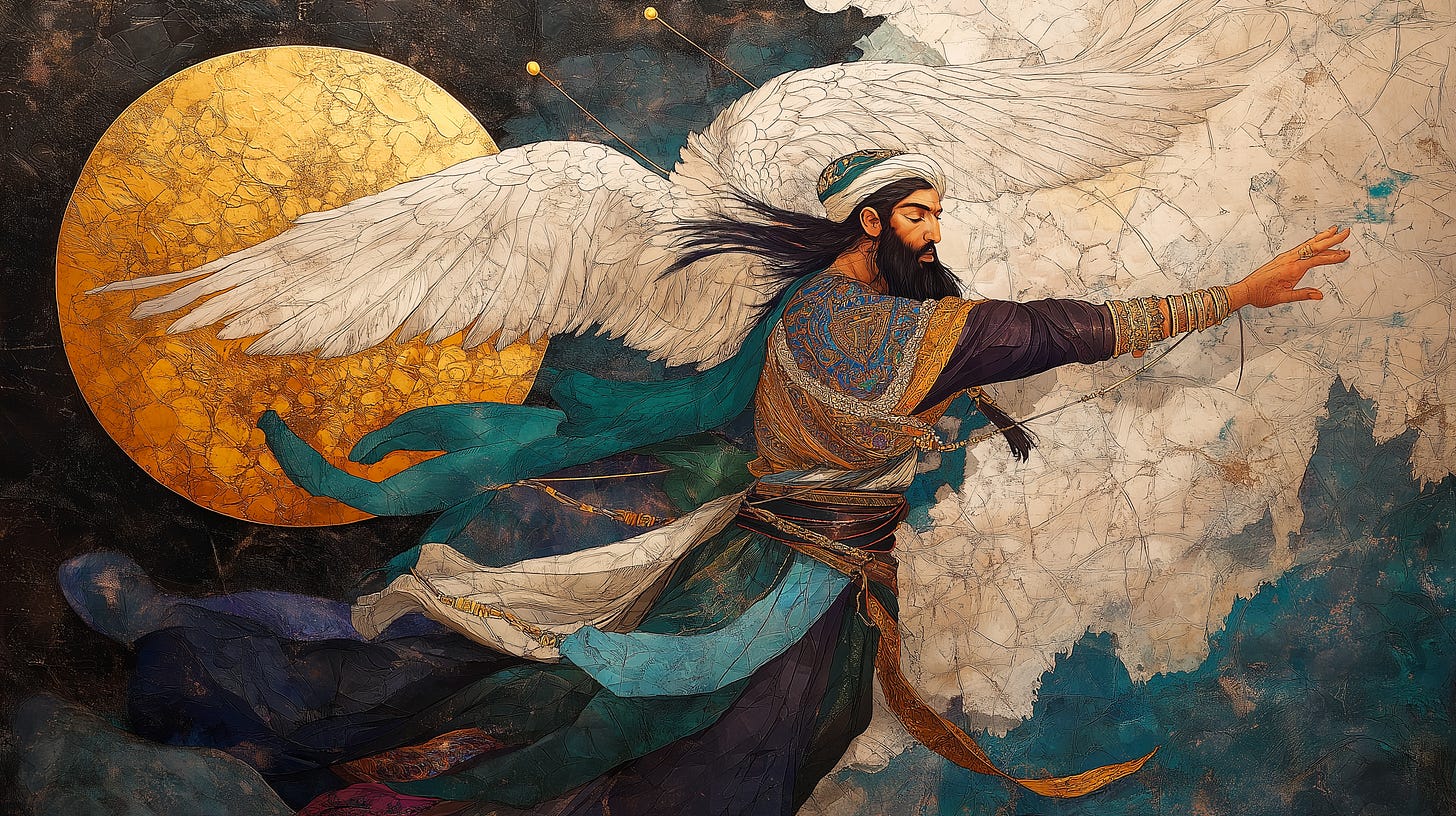Throughout human history, the bow and arrow have transcended mere weaponry to become a profound symbol of precision, purpose, and power. From the steady hand of Arjuna in Hindu mythology to Artemis's moonlit hunt in Greek lore, from Chinese archer Hou Yi saving the world to Norse goddess Skadi tracking through winter mountains—across cultures and millennia, the archer represents the perfect union of tension and release, of focus and flow.
In the Mahabharata, one of Hinduism's foundational texts, the great warrior Arjuna stands on the battlefield of Kurukshetra, bow drawn and vision clear. Yet his heart is heavy with the complexity of his task. He is not merely an archer but a leader facing uncertainty and impossible stakes. His bow represents not just strength but integrity; his arrows are decisions shaped by clarity, purpose, and alignment.
Today's leaders face their own Kurukshetra—navigating a landscape of compounding crises, accelerating change, and fragmented meaning. Leading effectively now demands the mythic qualities of the bow and arrow: precision, presence, and the ability to transform tension into forward momentum. The bow itself speaks to that perfect balance between flexibility and rigidity. Too rigid, and the bow snaps under pressure. Too flexible, and it lacks the power to propel the arrow toward its target.
Building on my recent essay on Integrity-Driven Leadership (IDL), I've distilled this wisdom into a framework that brings mythic archery principles into the ethos of Congruence's Executive Coaching practice. This is where our ARROW Framework takes flight: Authenticity, Resilience, Results, Ownership, Wisdom.
Authenticity
This tension echoes through the ARROW framework, where Authenticity requires leaders to remain supple enough to adapt while maintaining the structural integrity of their core values.
Consider Artemis, the Greek goddess of the hunt, moving through moonlit forests with her silver bow. She represents leadership that flows from the inside out—her arrows fly true because there is no discord between who she is and how she acts in the world. This seamless authenticity forms the string that binds our framework together. The authentic leader, like Artemis, doesn't waste energy maintaining a façade; instead, channeling that power directly into purpose.
When leaders stay true to their personal values and purpose, even under pressure, they create the unshakable foundation needed to face our era's polycrisis. Like the archer who must keep their feet grounded while reaching for the sky, authenticity creates stability amid chaos. Without this root system to clarify one’s own internal compass, leaders become weathervanes rather than waypoints—reactive rather than responsive to the winds of change.
Resilience
The resilience component of our framework finds its mythic echo in figures like Greek mythology's Perseus, who had to master indirect vision to overcome Medusa's petrifying gaze. Today's leadership demands adaptive capacity—the ability to recover and even thrive when facing setbacks, volatility, and uncertainty. The resilient leader, like a well-crafted bow, can absorb tremendous pressure without breaking, transforming that tension into forward momentum. This capacity to bend without breaking distinguishes those who merely survive challenges from those who emerge stronger and more capable because of them.
This resilience isn't mere endurance—it's creative adaptation. Consider how Perseus could not look directly at Medusa without turning to stone. His solution wasn't brute force but ingenious reflection—using his polished shield to see indirectly what would destroy him if viewed head-on. Today's leaders similarly must develop capacities to perceive threats obliquely, to find pathways around seemingly insurmountable obstacles. The most resilient leaders cultivate this reflective capacity—the ability to step back and perceive patterns that remain invisible from within the fray. They know when to draw back the bow to gather potential energy and when to release, transforming challenge into opportunity through perspective shifts that others miss.
Results
In Chinese mythology, when Hou Yi shot down nine of the ten suns that were scorching the earth, he demonstrated the archer's unwavering commitment to results. His actions weren't symbolic gestures but concrete interventions with measurable outcomes—cooling the planet, saving crops, preserving life. The third element of our ARROW framework similarly emphasizes the delivery of strategically meaningful outcomes for businesses and stakeholders. Like Hou Yi's arrows, leadership actions must fly beyond intention into tangible impact, creating value that can be measured and experienced by those who depend on the leader's vision and execution.
Results-oriented leadership requires precision and discernment—knowing which targets truly matter among the countless possibilities competing for attention. Just as Hou Yi left one sun in the sky, understanding that complete darkness would be as devastating as overwhelming heat, integrity-driven leaders recognize the importance of balanced outcomes that serve multiple stakeholders. They develop metrics that capture not just immediate gains but sustainable progress, measuring success through the lens of long-term impact rather than short-term advantage. The results component of our framework challenges leaders to aim their arrows not merely at what is easy to hit but at what truly needs to be transformed—focusing resources where they will create lasting value rather than fleeting impressions.
Ownership
The Persian tale of Arash the Archer illuminates our framework's emphasis on ownership. When called to determine the boundary between warring nations, Arash poured his life force into a single arrow, knowing his body would be found where the arrow landed. This cosmic level of accountability reflects how integrity-driven leaders take full responsibility for their decisions, their follow-through, and the broader impact on people and planet. True ownership, like Arash's final shot, acknowledges that our choices travel far beyond our immediate sphere of influence, creating ripples that may affect landscapes we will never personally witness.
Ownership in leadership means standing fully in one's power while simultaneously recognizing the profound responsibility that comes with that position. It requires leaders to claim both successes and failures with equal honesty, understanding that accountability isn't punitive but transformative—it creates the conditions for learning and growth. Like an archer who must account for wind, distance, and gravity before releasing the arrow, ownership-centered leaders consider the full spectrum of potential consequences before acting. They understand that their decisions, once released, cannot be called back—and so they aim with careful intention, ready to stand by the outcomes of their choices even when those outcomes challenge them to evolve beyond their current capabilities.
Wisdom
The Norse goddess Skadi, who hunts with bow through winter mountains, embodies the wisdom component of our framework. Her mastery comes not from comfortable theorizing but from intimate engagement with harsh landscapes—reading subtle signs in snow and forest that others might miss. Leadership wisdom similarly arises from blending insight, experience, and moral clarity to make sound, far-reaching decisions. The wise leader, like Skadi, tracks patterns across seemingly disconnected terrains, recognizing the subtle interconnections that define our complex reality. They cultivate the patience to observe deeply before acting, understanding that wisdom reveals itself to those who have developed the capacity to perceive beyond surface appearances
Wisdom integrates all other elements of our framework—it's the quality that allows a leader to know when authenticity requires bold expression and when it calls for quiet presence; when resilience means standing firm and when it demands creative adaptation; when results should be pursued aggressively and when they must be allowed to emerge organically; when ownership means claiming authority and when it requires surrendering control. Like the archer who must know precisely when to release the arrow—neither too soon nor too late—the wise leader develops exquisite timing. They understand that leadership, at its highest expression, is not about imposing one's will but about aligning with deeper currents of possibility that flow through organizations and communities. The wise leader, like all mythic archers, ultimately realizes that the target and the one who aims are not separate—they are part of a unified field of creative potential waiting to be activated through focused attention and purposeful action.
From Framework to Practice
What unites these mythic archers—and the elements of our ARROW framework—is their integration of opposing forces. The bow itself represents wholeness, a technology that harnesses tension to create purpose and direction. It transforms potential energy into kinetic action, just as great leadership transforms vision into reality.
When Krishna advises Arjuna before battle,
Focus on the eye of the bird, not the branch, not the sky, not even the bird itself—only the eye.
He speaks to the discernment essential in our age of information overload and attention scarcity. The archer's focus becomes the leader's clarity of purpose.
At Congruence, we've witnessed how this framework creates a compass for navigating leadership challenges. When executives integrate authenticity, resilience, results, ownership, and wisdom, they develop what ancient archers called "the still point"—the ability to maintain coherence even while stretching toward distant horizons. Their decisions fly true not because they control all variables but because they have learned to read patterns, account for unseen forces, and align with energies larger than themselves.
In the end, leadership, like archery, is a practice of presence—being fully where you are while aiming toward where you need to go. As we navigate our collective and personal challenges, the ARROW framework offers modern leaders this ancient wisdom: in a world of compounding crises, our greatest strength lies not in force but in focus, not in control but in coherence, not in certainty but in clarity of purpose.
Like Arjuna on the battlefield, we are called to act with precision, not despite our complexity but because of it—to draw the bow of possibility with steady hands and release decisions that fly true to their intended mark.
With gratitude,
Rachel
Founder, Executive Coach, & Speaker of Congruence
Curious to experience the ARROW framework firsthand through Congruence's Executive Coaching?
Emergence with Rachel Weissman is a weekly exploration of the interconnections between consciousness, technology, and planetary flourishing.
If you find this writing valuable, leave a heart ❤️, share it with a friend, and consider subscribing if you haven’t already.









